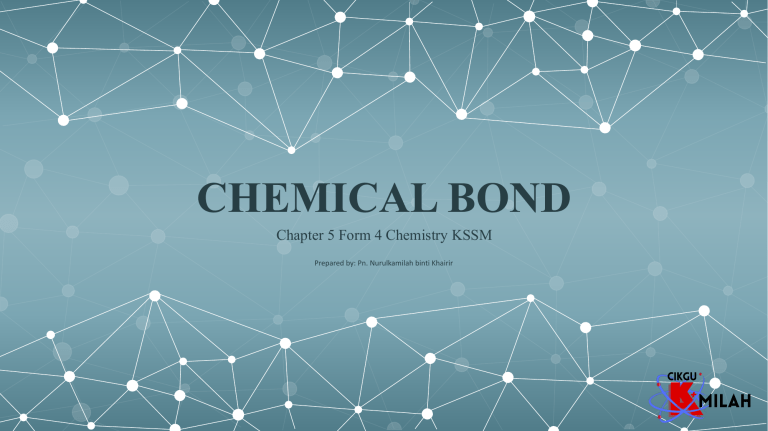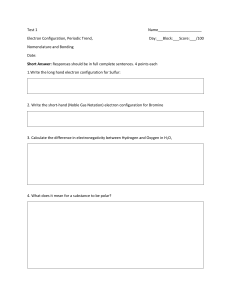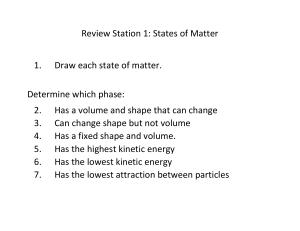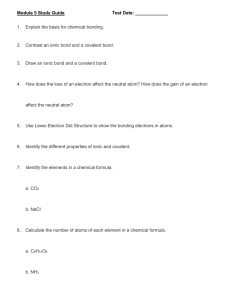
CHEMICAL BOND Chapter 5 Form 4 Chemistry KSSM Prepared by: Pn. Nurulkamilah binti Khairir Chemical Bond 5.1 Basics of Compound Formation 5.2 Ionic Bond 5.3 Covalent Bond 5.4 Hydrogen Bond 5.5 Dative Bond 5.6 Metallic Bond 5.7 Properties of Ionic Compounds and Covalent Compound 5.1 Basics of Compound Formation Learning Standard At the end of the lesson, pupils are able to 5.1.1 Explain the basics of compound formation Video of Formation of Compounds Ionic bond Covalent bond 5.1 Basics of Compound Formation Noble gases exists as monoatomic gases and are not reactive chemically Because they have achieved stable duplet or octet electron arrangement However, for atoms of other elements, stability of electron arrangement can be achieved by transferring or sharing of electrons Chemical bonds are formed when electron transfer or electron sharing takes place There are two types of chemical bonds; ionic bond and covalent bond and only involve the valence electrons 5.1 Basics of Compound Formation 5.1 Basics of Compound Formation 5.1 Basics of Compound Formation Test Yourself 5.1 Page 111 Chemistry Form 4 KSSM Text Book 5.2 Ionic Bond Learning Standard At the end of the lesson, pupils are able to 5.2.1 Explain with examples the formation of ionic bond 5.2 Ionic Bond 5.2 Ionic Bond Metal atom donates valence electron to form cation Non-metal atom receives electron to form anion 5.2 Ionic Bond 5.2 Ionic Bond 5.2 Ionic Bond 5.2 Ionic Bond 5.2 Ionic Bond – Magnesium oxide, MgO Magnesium atom has 12 electrons. The electron arrangement for magnesium atom is 2.8.2. Oxygen atom has 8 electrons. The electron arrangement for oxygen atom is 2.6. Mg O 5.2 Ionic Bond – Magnesium oxide, MgO Magnesium atom donates 2 electrons to form magnesium ion, Mg2+ To achieve stable octet electron arrangement Oxygen atom receives 2 electrons to form oxide ion, O2To achieve stable octet electron arrangement 2+ Mg Mg 🡪 Mg2+ + 2e- 2- O O + 2e- 🡪 O2- 5.2 Ionic Bond – Magnesium oxide, MgO Magnesium ion, Mg2+ ion and oxide ion, O2- are attracted by strong electrostatic force. A compound magnesium oxide, MgO is formed 2+ Mg 2- O 5.2 Ionic Bond – Sodium chloride, NaCl Sodium atom has 11 electrons. The electron arrangement for sodium atom is 2.8.1. Na Chlorine atom has 17 electrons. The electron arrangement for chlorine atom is 2.8.7. Cl 5.2 Ionic Bond – Sodium chloride, NaCl Sodium atom donates 1 electron to form sodium ion, Na+ To achieve stable octet electron arrangement Chlorine atom receives 1 electron to form chloride ion, ClTo achieve stable octet electron arrangement _ + Na Na 🡪 Na+ + e- Cl Cl + e- 🡪 Cl- 5.2 Ionic Bond – Sodium chloride, NaCl Sodium ion, Na+ and chloride ion, Cl- are attracted by strong electrostatic force. A compound sodium chloride, NaCl is formed _ + Na Cl 5.2 Ionic Bond – Sodium oxide, Na2O Sodium atom has 11 electrons. The electron arrangement for sodium atom is 2.8.1. Na Oxygen atom has 8 electrons. The electron arrangement for oxygen atom is 2.6. O 5.2 Ionic Bond – Sodium oxide, Na2O Sodium atom donates 1 electron to form sodium ion, Na+ To achieve stable octet electron arrangement Oxygen atom receives 2 electrons to form oxide ion, O2To achieve stable octet electron arrangement + + 2- Na O Na 🡪 Na+ + e- O + 2e- 🡪 O2- Na 5.2 Ionic Bond – Sodium oxide, Na2O Sodium ion, Na+ and oxide ion, O2- are attracted by strong electrostatic force. A compound sodium oxide, Na2O is formed + Na 2- O + Na Test Yourself 5.2 Page 114 Chemistry Form 4 KSSM Text Book Test Yourself 5.2 5.3 Covalent Bond Learning Standard At the end of the lesson, pupils are able to 5.3.1 Explain with examples the formation of covalent bond 5.3.2 Compare ionic bond and covalent bond 5.3 Covalent Bond Diamond is the hardest substances in the world The property of diamond is caused by the formation of covalent bond between carbon atoms 5.3 Covalent Bond Non-metal Non-metal Covalent bonds are formed when non-metal atoms share their electrons to achieve a stable duplet or octet electron arrangement 5.3 Covalent Bond Single covalent bond 01 Formed when two atoms share a pair of electrons Triple covalent bond 03 Formed when two atoms share three pairs of electrons Double covalent bond 02 Formed when two atoms share two pairs of electrons 5.3 Covalent Bond 5.3 Covalent Bond The formation of covalent bond can be visualised using the Lewis structure. Lewis structure only shows the valence electrons of the atoms involved. A pair of electrons shared, is represented with a line between the two atoms 5.3 Covalent Bond 5.3 Covalent Bond 5.3 Covalent Bond 5.3 Covalent Bond – Hydrogen, H2 Hydrogen atom has 1 electron. The electron arrangement for hydrogen atom is 1. H 5.3 Covalent Bond – Hydrogen, H2 Each hydrogen atom contributes one electron for sharing with each other to achieve stable duplet electron arrangement. H H H H Two hydrogen atoms share one pair of electrons to form one single covalent bond. Hydrogen molecule, H2 is formed Lewis structure: 5.3 Covalent Bond – Hydrogen chloride, HCl Hydrogen atom has 1 electron. The electron arrangement for hydrogen atom is 1. Chlorine atom has 17 electrons. The electron arrangement for chlorine atom is 2.8.7. H Cl 5.3 Covalent Bond – Hydrogen chloride, HCl The hydrogen atom contributes one electron for sharing to achieve stable duplet electron arrangement. The chlorine atom contributes one electron for sharing to achieve stable octet electron arrangement. H Cl H Cl One hydrogen atom and one chlorine atom share one pair of electrons to form one single covalent bond. Hydrogen chloride molecule, HCl is formed Lewis structure: 5.3 Covalent Bond – Oxygen, O2 Oxygen atom has 8 electrons. The electron arrangement for oxygen atom is 2.6. O 5.3 Covalent Bond – Oxygen, O2 Each oxygen atom contributes two electrons for sharing with each other to achieve stable octet electron arrangement. O O O Two oxygen atoms share two pairs of electrons to form one double covalent bond. Oxygen molecule, O2 is formed Lewis structure: O 5.3 Covalent Bond – Carbon dioxide, CO2 Carbon atom has 6 electron. The electron arrangement for carbon atom is 2.4. C Oxygen atom has 8 electrons. The electron arrangement for oxygen atom is 2.6. O 5.3 Covalent Bond – Carbon dioxide, CO2 The carbon atom contributes four electrons for sharing to achieve stable octet electron arrangement. Each oxygen atom contributes two electrons for sharing to achieve stable octet electron arrangement. O C O One carbon atom and two oxygen atoms share four pair of electrons to form two double covalent bond. Carbon dioxide molecule, CO2 is formed Lewis structure: 5.3 Covalent Bond – Nitrogen, N2 Nitrogen atom has 7 electrons. The electron arrangement for nitrogen atom is 2.5. N 5.3 Covalent Bond – Nitrogen, N2 Each nitrogen atom contributes three electrons for sharing with each other to achieve stable octet electron arrangement. N N N Two hydrogen atoms share one pair of electrons to form one single covalent bond. Hydrogen molecule, H2 is formed Lewis structure: N 5.3 Covalent Bond Test Yourself 5.3 Page 117 Chemistry Form 4 KSSM Text Book Test Yourself 5.3 Test Yourself 5.3 Test Yourself 5.3 Test Yourself 5.3 5.4 Hydrogen Bond Learning Standard At the end of the lesson, pupils are able to 5.4.1 Explain with examples the formation of hydrogen bond 5.4.2 Explain the effect of the hydrogen bond on physical properties of substances 5.4 Hydrogen Bond An iceberg weighing thousands of tonnes is able to float on the surface of the sea This is because the density of ice is lower than water This is due to the presence of hydrogen bond in water 5.4 Hydrogen Bond Hydrogen bonds are attraction forces between hydrogen atom, H that has bonded with an atom of high electronegativity such as N, O or F with N, O or F in another molecule. 5.4 Hydrogen Bond 5.4 Hydrogen Bond in hydrogen fluoride, HF H-F Fluorine atom, F has high electronegativity H-F Attraction forces between hydrogen atom, H in hydrogen fluoride molecule with fluorine atom, F, from another hydrogen fluoride molecule forms a hydrogen bond 5.4 Hydrogen Bond in ammonia, NH3 H H-N-H Nitrogen atom, N has high electronegativity H N-H H Attraction forces between hydrogen atom, H in ammonia molecule with nitrogen atom, N, from another ammonia molecule forms a hydrogen bond 5.4 Hydrogen Bond – Role in Daily Life There are protein molecules that form hydrogen bonds among one another in the hair structure. 5.4 Hydrogen Bond – Role in Daily Life When hair is wet, protein molecules no longer form hydrogen bond between themselves. Instead, protein molecules will form hydrogen bonds with water molecules, H2O. Water molecules also form hydrogen bonds with other hair protein molecules. This causes hair to stick together. 5.4 Hydrogen Bond – Role in Daily Life 5.4 Hydrogen Bond – Role in Daily Life When turning the pages of a book, you lick your finger before turning the pages. 5.4 Hydrogen Bond – The Effect on Physical Properties of Substances 01 Compounds in the form of liquids reach boiling point when the attraction forces between molecules are overcome 02 In the covalent compound of ethanol, C2H5OH, there are hydrogen bonds formed between molecules, other than weak Van der Waals attraction forces 03 Strong hydrogen bonds are difficult to break. More heat energy is required to overcome the weak Van der Waals attraction forces, besides breaking the hydrogen bonds 04 As a result, the boiling point of ethanol is high. Cl2 molecules do not form hydrogen bonds have lower boiling point compared to ethanol 5.4 Hydrogen Bond – The Effect on Physical Properties of Substances 5.4 Hydrogen Bond Test Yourself 5.4 Page 119 Chemistry Form 4 KSSM Text Book Test Yourself 5.4 Test Yourself 5.4 Test Yourself 5.4 5.5 Dative Bond Learning Standard At the end of the lesson, pupils are able to 5.5.1 Explain with examples the formation of dative bond 5.5 Dative Bond 5.5 Dative Bond 5.5 Dative Bond 5.5 Dative Bond in ammonium ion, NH4 + Test Yourself 5.5 Page 121 Chemistry Form 4 KSSM Text Book Test Yourself 5.5 Test Yourself 5.5 Test Yourself 5.5 5.6 Metallic Bond Learning Standard At the end of the lesson, pupils are able to 5.6.1 Explain the formation of a metallic bond 5.6.2 Reason out the electrical conductivity of metal 5.6 Metallic Bond Why can metals conduct electricity? 1. Metal atoms are arranged closely packed and orderly in the solid state 2. Valence electrons of metal atoms can be donated easily and delocalized although in the solid state 3. Metal ions that are positively-charged are formed when valence electrons are delocalized 4. All delocalized valence electrons can move freely between the metal structure and form a sea of electrons 5. Electrostatic attraction force between the sea of electrons and the positively-charged metal ions form the metallic bond 5.6 Metallic Bond 5.6 Metallic Bond 5.6 Metallic Bond 6. When electrons of metal atoms are delocalised in the sea of electrons, the metal can conduct electricity 7. Electrons that move freely in the metal structure carry the charges from the negative terminal to the positive terminal when electricity is supplied 5.6 Metallic Bond Test Yourself 5.6 Page 122 Chemistry Form 4 KSSM Text Book Test Yourself 5.6 5.7 Properties of Ionic Compounds and Covalent Compounds Learning Standard At the end of the lesson, pupils are able to 5.7.1 Compare the properties of ionic compounds and covalent compounds through experiment 5.7.2 Explain with examples the uses of ionic compounds and covalent compounds in daily life 5.7 Properties of Ionic Compounds and Covalent Compounds 5.7 Properties of Ionic Compounds and Covalent Compounds 5.7 Properties of Ionic Compounds and Covalent Compounds 5.7 Properties of Ionic Compounds and Covalent Compounds 5.7 Properties of Ionic Compounds and Covalent Compounds 5.7 Properties of Ionic Compounds and Covalent Compounds 5.7 Properties of Ionic Compounds and Covalent Compounds 5.7 Properties of Ionic Compounds and Covalent Compounds 5.7 Properties of Ionic Compounds and Covalent Compounds 5.7 Properties of Ionic Compounds and Covalent Compounds 5.7 Properties of Ionic Compounds and Covalent Compounds – Electrical Conductivity 5.7 Properties of Ionic Compounds and Covalent Compounds – Electrical Conductivity 5.7 Properties of Ionic Compounds and Covalent Compounds – Electrical Conductivity 5.7 Properties of Ionic Compounds and Covalent Compounds – Solubility in Water and Organic Solvents 5.7 Properties of Ionic Compounds and Covalent Compounds – Solubility in Water and Organic Solvents 5.7 Properties of Ionic Compounds and Covalent Compounds – Solubility in Water and Organic Solvents 5.7 Properties of Ionic Compounds and Covalent Compounds – Solubility in Water and Organic Solvents 5.7 Properties of Ionic Compounds and Covalent Compounds – Solubility in Water and Organic Solvents 5.7 Properties of Ionic Compounds and Covalent Compounds – Melting Point and Boiling Point 5.7 Properties of Ionic Compounds and Covalent Compounds – Melting Point and Boiling Point 5.7 Properties of Ionic Compounds and Covalent Compounds – Melting Point and Boiling Point 5.7 Properties of Ionic Compounds and Covalent Compounds – Structure of Covalent Compounds 5.7 Properties of Ionic Compounds and Covalent Compounds – Uses in Our Daily Life 5.7 Properties of Ionic Compounds and Covalent Compounds – Uses in Our Daily Life 5.7 Properties of Ionic Compounds and Covalent Compounds Test Yourself 5.7 Page 130 Chemistry Form 4 KSSM Text Book 5.7 Properties of Ionic Compounds and Covalent Compounds Test Yourself 5.7 Test Yourself 5.7 Test Yourself 5.7 ACHIEVEMENT TEST 5 Achievement Test 5 Achievement Test 5 Achievement Test 5 Achievement Test 5 Achievement Test 5 Achievement Test 5 Achievement Test 5 Achievement Test 5 Achievement Test 5 Achievement Test 5 Achievement Test 5 Enrichment Corner Enrichment Corner THANK YOU Prepared by: Puan Nurulkamilah binti Khairir





